The Origin of Flight in Insects
Insects are part of the Insecta sub-phylum within the arthropod (jointedlegged) phylum. Insects are one of the four living groups on Earth with the ability to fly, the others being birds, flying reptiles and bats.
The origin of flight in insects, as with the other groups, also constitutes a huge dilemma for the theory of evolution.
But so is the origin of insects in general an insoluble puzzle for evolutionists!
The oldest insect fossils date back to the Devonian Period (417 to-354 million years ago). Insects in the strata from this period appear suddenly, with flawless structures, and no living organisms can be proposed as their ancestors. As the well-known French paleontologist Pierre Paul Grassé says, "We are in the dark concerning the origin of insects." 225
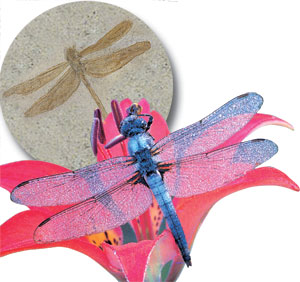 |
| A fossil dragonfly, called Meganeura, dating back to the Late Carboniferous (306 million years), is identical to specimens alive today. |
For example, cockroaches appear suddenly and with their present-day structures in the Earth's strata. Betty Faber, of the American Museum of Natural History, states that fossilized roaches from 350 million years ago are exactly the same as those of today. 226 Anthropods such as spiders, acarid and centipedes are not true insects, although they are usually referred to as such. Very significant fossils of these creatures were presented at the annual meeting of the American Association for the Advancement of Science in 1983. The most striking feature of these 380-million-year old fossils was their being identical to present-day specimens. One of the scientists who examined them commented, "they looked like they might have died yesterday." 227
The oldest known flying insects are dragonflies, which appear in the Pennsylvanian Period (325 to 286 million years ago). Just like the other species in the fossil record, they appear suddenly, and with no ancestors. For instance, a 320-million-year-old fossil dragonfly has exactly the same wing structure and characteristics as living specimens.
Other flying insects such as the housefly, which pose still more dilemmas for evolutionists, appear in the same fossil strata as other species of wingless insects. This demolishes the claim that winged insects evolved from wingless ones. In their book Biomechanics in Evolution, Robin Wootton and Charles P. Ellington write:
When insect fossils first appear, in the Middle and Upper Carboniferous, they are diverse and for the most part fully winged. There are a few primitively wingless forms, but no convincing intermediates are known. 228
The theory of evolution claims that living things have evolved from the primitive to the more developed. Therefore, the fact that these insects have the same features as their present-day counterparts and that no primitive creatures lived before them is evidence that they did not come into existence through evolution. Almighty Allah, Lord of the Worlds, created insects like all other living things, together with the physical structures and wings that enable them to fly.
The Special Anatomy for Flight in Insects
 |
| Professor Michael Dickinson |
These tiny creatures amaze scientists by their ability to hover suspended in the air, fly backwards, suddenly accelerate to more than 150 kilometers/hour (93.205 miles per hour) and engage in superior acrobatics to any fighter pilot. Insects have highly advanced mechanisms for flight, including perfect wings, a light exoskeleton, balance organs, and advanced warning systems that enable them to navigate and take off. Their bodies are covered by an exoskeleton that fulfill a set of functional roles including moving their legs and wings.
Over the last 30 years, the scientific world has made it a priority to understand insects' superior flying performance. Airplanes operate by using the flow of air over their wings and are propelled with the assistance of engines. Insects, on the other hand, have no engines for takeoff, but beating their wings gives them a powerful lift. 229
In order to take off, most insects have to beat their thin wings very fast— and during flight, an average of several hundred times a second.230 Some insects beat their wings 600 times a second. Such rapid movement taking place in so short a time is impossible to be replicated technologically.
California University Professor of Biology Michael Dickinson and his team developed a robot to duplicate the flight technique of fruit flies. Yet their robot is 100 times larger than a fly and can open and close its wings at a speed only 1,000 times slower than the fruit fly can. Furthermore, in order to replicate the fly's actions, the robot—which can only move its wing once every five seconds—must use six separate engines. 231
Many scientists like Professor Dickinson have for years carried out numerous experiments in order to expose the wing beating actions of flies. During these experiments, Dickinson determined that fruit flies do not use a simple up-and-down movement, as if their wings were hinged, but use very complex aerodynamic techniques. Moreover, their wings change direction with every beat. Scientists seeking to analyze the complex technique state that the classical aerodynamics employed for plane wings is insufficient, because fruit flies make use of more than one aerodynamic principle. The flight muscles that permit the 2.5-millimeter (0.098-inch) fruit fly to beat its wings 200 times a second are regarded as the most powerful in any insect.232 The Turkish magazine Hürriyet Bilim refers to the perfection of the balance and speed as the flies beat their wings:
The Dragonfly Flight System is a Marvel of Creation
Dragonflies cannot fold their wings, and their flight muscles and the way they move their wings are different from those of other insects. On account of these features alone, evolutionists refer to dragonflies as "primitive" insects. Yet their flight system is actually a marvel of creation.
Skorsky, the world's foremost helicopter manufacturer, used the dragonfly as a model for one of the helicopters it developed.1 IBM, which collaborated with Skorsky on this project, transferred a dragonfly's image onto an IBM 3081 computer. Some 2000 special images were then produced, based on the dragonfly's aerial maneuvers. By the end of the study, Skorsky used the model that emerged to produce a helicopter for carrying troops and equipment.
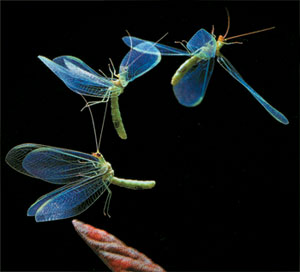 |
Nature photographer Gillian Martin carried out a two-year study of dragonflies,2 which showed that these insects possess a highly complex flight system.
The dragonfly's head, thorax, and segmented abdomen give the impression that it is covered in metal or plastic. Thanks to the two diagonal pairs of wings on its throrax, which can be of various colors from ice-blue to dark red, the dragonfly has a very high level of maneuverability. No matter what its speed and direction, it can suddenly stop and begin flying in the opposite direction—or hover in the air, waiting for a suitable moment to attack its prey. From there, it can perform sharp turns as it goes into the attack, quickly attaining a speed of 40 kilometer/hour (24.85 miles per hour), which is astonishing for an insect. Sprinters running at the Olympic Games can manage only 39 kilometers/hour (24.23 mph).
The dragonfly also has perfect sight. Its two wraparound eyes are regarded as the best in the insect world. Each eye consists of up to 30,000 separate lenses. These eyes, each of which is semi-spherical and covers half of its head, provide a very wide field of vision—the dragonfly can even see what is going on behind it.3
As you see, the dragonfly's various systems constitute a perfect whole. The slightest deficiency in any one will cause the others to cease functioning. Yet since they have all been created flawlessly, the insect has thrived for millions of years.
It is very dangerous for a pilot to bend perpendicular wings. As the plane takes off, the air current acting on the wing finds it more difficult to attach to the wing edge. When the current disappears completely, the plane wobbles and loses height. On the other hand, this is an advantage for the fruit fly, because it does not have to maintain its wings in one position. The fly beats its wings so quickly that the wings perform another movement by the time that the edge directing the flight ceases to be in contact with the air current. At the end of every movement, it rotates its wings around themselves, causing them to beat in the opposite direction. This forms a vortex and no instability takes place. 233
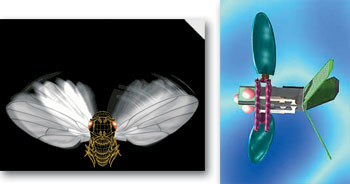 |
| One of the experiments that Dickinson set up to determine and replicate the flying technique in insects. Drosophila melanogaster: this fruit fly, beating its wings 200 times a second, has one of the complex aerodynamic properties in nature. Above is a simulation image of a time frame of just 1/1,000th of a second. |
The fine channels in insects' wings permit air and blood to flow through them.234 With flies, however, a great many additional details—such as their sharp eyes, the small rear wings they use for balance, and the receptors that regulate the wings' timing—further demonstrate the perfection in their creation. All of these must exist and operate at the same time. If the thorax muscles lack sufficient energy, or if the insect's metabolism can't provide the wingbeats frequent enough, these shortcomings by themselves will be sufficient to prevent flight taking place. The fact that all these systems in the fly's body work together in perfect harmony is one of the proofs of Almighty Allah's sublime creation.
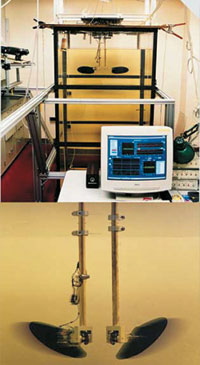 |
| In studying the aerodynamics of insect flight with advanced technology, Dickinson and his team were still unable to fully understand the insects' flawless maneuverability. |
The theory of evolution tries to account for insect flight by claiming that flight evolved independently in each different group of flying insects. Wings—which could not have developed even once through random mutations—are depicted as having evolved separately four times in some species.
Indeed, the evolutionist scenario claims that wings evolved once, subsequently disappeared, evolved again, and disappeared yet again. For example, one article in Nature magazine suggested that after losing its wings, the stick-insect (Phasmatodea) preserved the muscular and nervous systems for flight, and that its wings re-appeared at a later date. This claim isn't accepted even among evolutionists. Although Nature used this account as its cover story, it also states that this claim flies in the face of the theory's structure agreed upon by evolutionists. 235
New Scientist states that such claims attracted a strong reaction from entomologists, along the lines of "Impossible, impossible, impossible."236 In a report in Science News, Michael F. Whiting comments, "It's as if a mammalogist found a whale walking around on legs." 237
Evolutionists see there is no basis to their claims, yet they still insist on ignoring the fact and using hollow words in forced evolutionary accounts. However, the evidence that living things were created from nothing is too strong. Even if evolutionists are reluctant to accept the fact, Allah's magnificent artistry and infinite knowledge manifest themselves throughout the universe.
In one verse of the Qur'an, Allah reveals that human beings should reflect upon the fact of creation:
O humanity! An example has been made, so listen to it carefully. Those whom you call upon besides Allah are not even able to create a single fly, even if they were to join together to do it. And if a fly steals something from them, they cannot get it back. How feeble are both the seeker and the sought! (Surat al-Hajj, 73)
The Supperior Flight Techniques of Insects
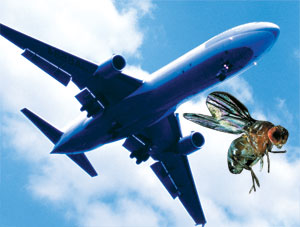 |
Insect flight is too complex to be replicated, despite the advanced 21st century technology and accumulated knowledge in the field of engineering. The structures that make this action possible in flies are, according to scientists, a marvel of technology. From this point of view, they are like robots created for flight. Biology professor Michael Dickinson compares flies to marvels of mechanical technology and goes on to say:
Flies are extraordinary creatures. Human beings invariably see them every day, but we may be unaware of them. These extraordinary, tiny machines fly about right at the ends of our noses. 238
As long as science cannot account for the physical structures and flight techniques in insects, it is exceedingly irrational to claim that they came into existence by blind chance. The mutations that Darwinism offers as the architects of these changes are harmful effects that either cripple the living thing involved, causing permanent damage to its anatomy, or even result in death. Mutations based on random effects cannot possibly have given rise to such complex systems as a fly's wings, eyes, muscles, antennae, respiration and digestion. Human beings cannot open and close their arms even 10 times a second, whereas a fly can beat its wings 500 times a second. Moreover, they beat both wings simultaneously. The slightest imbalance in vibration between the wings will cause it to lose balance, yet such disharmony never arises.
In an article, "The Mechanical Design of Fly Wings," R. Wootton writes:
The better we understand the functioning of insect wings, the more subtle and beautiful their designs appear . . . Structures are traditionally designed to deform as little as possible; mechanisms are designed to move component parts in predictable ways. Insect wings combine both in one, using components with a wide range of elastic properties, elegantly assembled to allow appropriate deformations in response to appropriate forces and to make the best possible use of the air. They have few if any technological parallels—yet. 239
The Earth's Earliest Insect Fossil
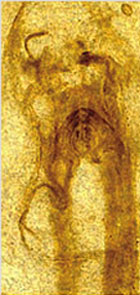
In February 2004, scientists announced discovery of the oldest known insect fossil. The findings, published in Nature magazine, put in insect flight, the technology of which is most complex, back to 170 million years ago.1 This fossil shows that there were also flying insects 70 million years before the oldest known fossilized insect wing. These fossilized creatures appear in the Earth's strata fully formed, with no intermediate forms leading up to them.
The theory of evolution, which regards blind chance as a creative force, cannot explain how creatures with such flawless structures appeared suddenly on Earth.
Flies also possess a high-speed maneuverability that has occupied the minds of designers and engineers for many years. If a fly sees a potential mate change direction, it can change its own direction accordingly in just 30 milliseconds (1/1,000th of a second). This astonishing coordination is the result of two small "balancing organs" known as the halters.
Since some insects have four wings, and others two, evolutionists claim that two-winged flies evolved from four-winged predecessors, and that the two rear wings either became useless and vanished or else developed into halters. These organs are known to function like the gyroscopes that keep planes from going off course. Just as it's impossible to claim that gyroscopes developed by chance, it's similarly impossible to maintain that a far superior and vitally important organ in insects is the result of unconscious coincidences.
Insect Flight, Which Even Scientist are Unable to Replicate is one of the Proofs of the Infinite Knowledge and of Allah
Engineers seeking to imitate insect flight are faced with the fact that flies turn their wings in a figure-eight movement. The wing surface facing upward in the first half of the cycle faces downwards in the second. In order to replicate such a flight, a plane would have to add revolving wings moving from a joint.
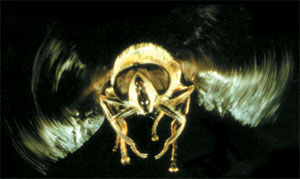 |
Even more difficult would be programming a computer to ensure the rapid and controlled movement of such wings. It is impossible even to dream of constructing such a system with present-day technology. The engineers seeking to replicate insect flight dream of producing robot insects whose flight can be controlled in the narrow corridors and rooms of buildings.
Experts at high-technology institutes say that in imitating insect flight, they regard themselves as being at the level of the Wright brothers in 1903.1 After describing of all these perfections in the fly, the way evolutionists claim that dinosaurs developed wings in order to catch insects is a striking example of the backward logic they employ. Evolutionists forget that flies too have wings, as well as even more amazing flying abilities. They cannot explain how the fly—which beats its wings 500 to 1,000 times a second and has a greater maneuverability than even the most advanced helicopters—came into existence.
1. "Robotic Insect Takes to the Air," Doctor Chris Riley, BBC News, 11 April 2001; http://news.bbc.co.uk/2/hi/science/nature/1270306.stm
Experiments reveal that the images that the fly's eye-brain system perceives automatically give rise to wing actions. However, this visual data goes directly to the halter organs, not to the wings. Moreover, according to Dickinson, the function of the halter organ is more important than had previously been thought. For example, halters enable the insect to fly at the same elevation. If the insect makes a sudden turn, the halters react like the flight muscles—a very intelligent and efficient aerodynamic technique. In this way, the device that establishes balance is always active, and the nervous system is regulated to control its mechanics at all times.
Examples of Almighty Allah's Knowledge Exhibited in Details |
 |
| ◉ A fruit fly can beat its wings 200 times a second |
| 1. "Sinekler Nasil Uçar?," (How Do Flies Fly?), Hürriyet Science Magazine, 22 March 2003. |
Dr. Cole Gilbert of Cornell University has shown that the fly sends information about the position of its head to the wings and halter organs. With this complex nerve network, it can perform complex activities that put our modern-day technology to shame.
To believe that halter organs of the greatest importance came into being by chance to meet the fly's needs is as irrational as believing that raw materials can come together at random to produce an airplane.
There is no evidence that flies evolved from any primitive ancestor. It is also clearly no evidence that the halter organs are useless remains left over from the rearmost wings. Experimental data and the fossil record reveal that flies were created together with all these advanced systems they need.
Flies have been using the laws of aerodynamics for millions of years. The fact that the most advanced modern technology cannot duplicate flies' flight techniques is one of the manifest proofs of creation. Allah manifests His infinite reason and knowledge in these tiny creatures. In one verse He reveals:
Allah is not ashamed to make an example of a mosquito or of an even smaller thing. As for those who believe, they know it is the truth from their Lord. But as for those who disbelieve, they say, "What does Allah mean by this example?" He misguides many by it and guides many by it. But He only misguides the deviators. (Surat al-Baqara, 26)
Aerodynamics in a Butterfly's Wings
 |
Researchers from Great Britain's Oxford University developed a new technique in order to study butterfly flight. They found that butterflies do not beat their wings at random, but actually use far more flight tactics than had previously been supposed.
Researchers from Cambridge University in England, on the other hand, observed that wing movements of peacock butterflies establish a vortex on the farthest extremity of the wing that enables the insect to rise in the air. According to Robert Srygley, a professor of behavioral ecology at South Korea University and also a researcher at Oxford University, investigations have shown that butterfly flight is far more complex:
Free-flying butterflies use all of the known mechanisms to enhance lift—wake capture, leading-edge vortex, clap and fling, and active and inactive upstrokes—as well as two mechanisms that had not been postulated, the leading-edge vortex during the upstrokes and the double leading-edge vortex. 240
To make sudden changes in their altitude, butterflies establish vortexes and double vortexes at the extremities of their wings by changing the rotation and speed of their wing beats, and use different aerodynamic stages in consecutive wing movements. According to Robert Srygley, the apparently random fluttering of butterflies is actually a series of different aerodynamic mechanisms as they maneuver and settles into level flight. Furthermore, there is a great deal that we do not know with regard to the flight of all insects:
Just about every flight mechanism in the insect world remains unexplained. 241
Robert Michelson, a research engineer at the Georgia Technical Research Institute, emphasizes that the various aerodynamics displayed during the various forms of butterfly flight are quite astonishing. In his research, he used a robot known as an entomopter that beats its tiny wings and states that insect wings are "physically complex, difficult to miniaturize."242 Wing control consumes high levels of energy. This research, according to the California University Electrical Engineering Faculty Professor Ron Fearing, contributes to our understanding of the variety of aerodynamics in nature.
In fact, all these creatures studied by scientists are just a few of the examples of Allah's creative artistry. Allah's infinite knowledge is plain for all to see, everywhere in nature.
Even scientists with no religious beliefs can't refrain from expressing their amazement at such sublime and incomparable knowledge.
That is Allah, your Lord. There is no god but Him, the Creator of everything. So worship Him. He is responsible for everything. (Surat al-An'am, 102)
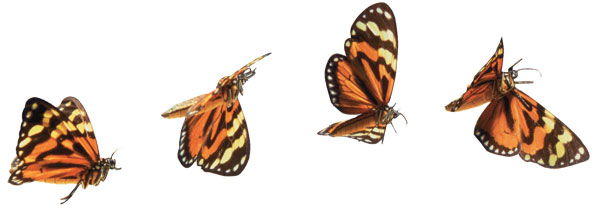 |
Scientists are Inspired by Insects' Flight Systems
Many research institutions aim to develop technology by imitating living beings in nature. (For details see, Harun Yahya, Biomimetics: Technology Imitates Nature, Istanbul: Global Publishing, March 2006).
Most of the robots and devices developed in recent years were inspired by nature. Insects are most frequently imitated, especially their exceedingly successful flying techniques. In recent years, Charles Ellington (a professor from Cambridge University), Robert Michelson (a research engineer from the Georgia Technical Research Institute) and others have shown that insects take advantage of their wings being very small by establishing vortexes that a plane never can—vortexes that they use during take-off and flight. 243
Miniature Flying Robots
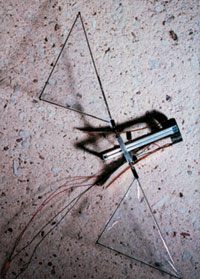 |
| The micro-mechanical flying insect prototype being developed at the University of California at Berkley. |
Biologists and technology experts from the University of California at Berkeley spent four years developing what they called the "Micromechanical Flying Robot," which they say will one day be able to navigate through the air like a fly so as to obtain covert intelligence about enemies, investigate the surface of the planet Mars, and monitor dangerous chemical wastes. They are planning devices that can climb to great heights, make sudden movements, and beat their wings with a precision so far to be found only in nature. Due to the importance of these studies, the Pentagon's Advanced Defense Research Project Center is providing the project with financial backing.
Although they have advanced technical expertise and all manner of material backing, scientists are still unable to imitate the dimensions, weight, energy and, most important of all, the aerodynamic delicacy of a tiny fly. Indeed, scientists express their amazement in the face of insects' flying abilities:
Aviation engineers look with envy on birds and especially insects. Their flapping wings lift and propel them far more efficiently than the fixed wings of aircraft. One reason is their ability to exploit the subtleties of stalling. If the angle of attack of a wing is increased, it ultimately stalls, with sudden disastrous loss of lift. No fixed-wing aircraft dare risk stalling. But an insect with oscillating wings can exploit an intriguing loophole in the laws of aerodynamics. Accelerated at a high angle of attack into the stalling regime, a wing takes a short while to stall. And until it does, it generates enormous lift. By speeding into stall and out again at each flap, an insect wing develops amazingly high average lift. 244
Tim Sands, a professor of material science and engineering, indicates how a fly to be able to lift its own weight, turn more quickly than any fighter jet, fly even if its wings are torn, and land on the ceiling.245 Ron Fearing agrees: "Insects have tremendous maneuverability."246 Michael Dickinson, a professor of biology from Berkeley University and eminent researcher into insect flight, says, "Flapping is much more aerodynamically efficient at small sizes than conventional aerodynamics."247
But making a robot that beats its wings is no easy matter. What really defeats scientists is the impossibility of giving that robot the intelligence that makes flight possible. Says Ron Fearing, "The good news is we know what the wings need to do. The bad news is we don't know how to do it."248 Michael Dickinson states that fruit flies beat their wings 200 times a second and use three different mechanisms in order to take off. This lets a fruit fly make a U-turn in the air with just eight wing movements, in as little as 40 milliseconds. 249
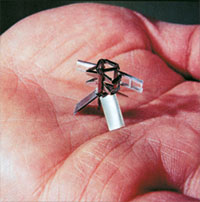 |
| A flying insect robot prototype still under development at the Vanderbilt School of Engineering. |
According to Dickinson, in order to achieve such a level of control, the insect robot at Berkeley can make mistakes only three times, approximately on the fourth one, it will drop dead. Robert Michelson, the chief engineer at Georgia Technology Research Institute, states how difficult it is to construct a robot that beats its wings for balance and control:
Until we can do things as well as you find them in Creation, you have to go to alternate techniques. 250
Even though we possess all the technology, intelligence, energy, and financial backing, we still cannot imitate the systems we witness in nature. These marvels of creation show just a few examples of Allah's matchless creative artistry.
It is illogical to ascribe the origin of these living things to chance. No coincidence can produce a helicopter, for instance. Even if all the components used in its manufacture were left out in the open, natural phenomena could never assemble the helicopter by chance. To maintain that such a thing is possible is just as illogical as to claim that an insect's wings could form by coincidence. The origin of insects clearly confirms creation.
In one verse Allah states:
Say: "Who is the Lord of the heavens and the Earth?" Say: "Allah." Say: "So why have you taken protectors apart from Him who possess no power to help or harm themselves?" Say: "Are the blind and seeing equal? Or are darkness and light the same? Or have they assigned partners to Allah Who create as He creates, so that all creating seems the same to them?" Say: "Allah is the Creator of everything. He is the One, the All-Conquering." (Surat ar-Ra'd, 16)
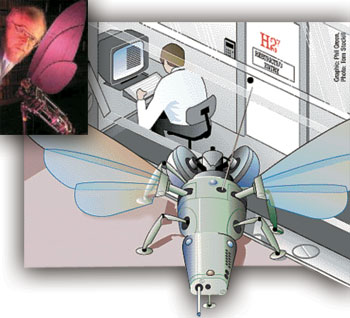 |
| While flying an insect beats its wings several hundred times a second. The way that so many movements take place under a second makes it impossible for this feat to be replicated technologically. |
Footnotes
225. Pierre P. Grassé, Evolution of Living Organisms, New York: Academic Press, , 1977, p. 30. 
226. M. Kusinitz, Science World, 4 February 1983, p. 19. 
227. New York Times Press Service, San Diego Union, 29 May 1983; W. A. Shear, Science, Vol. 224, 1984, p. 494 (Emphasis added), 
228. R. J. Wootton, C. P. Ellington, "Biomechanics & the Origin of Insect Flight," Biomechanics in Evolution, Ed. J. M. V. Rayner & R. J. Wootton, Cambridge: Cambridge University Press, , 1991, p. 99. 
229. Jeremy Thomson, "How Flies Fly," Nature, 22 August 2001; http://www.nature.com/ nsu/nsu_pf/010823/010823-10.htm 
230. Michael Dickinson, "Solving the Mystery of Insect Flight," Scientific American, June 2001; http://www. sciam. com/2001/0601issue/0601dickinson.html 
233. "Sinekler Nasıl Uçar?," Hürriyet Bilim magazine, 22 March 2003. 
234. http://wings.avkids.com/Book/ Animals/instructor/insects-01.html 
235. Michael F. Whiting, Sven Bradler, Taylor Maxwell, "Loss and recovery of wings in stick insects." Nature, Vol. 421, 16 January 2003, pp. 264-267. 
236. Nicola Jones, "Stick insect forces evolutionary rethink," New Scientist, 15 January 2003; http://www.newscientist.com/article.ns?id=dn3269 
237. Susan Milius, "Retaking Flight: Some insects that didn't use it didn't lose it," Science News, Vol. 163, No. 3, 18 January 2003, p. 35. 
238. "Sinekler Nasıl Uçar," Hürriyet Bilim magazine, 22 March 2003. 
239. Robin J. Wootton, "The Mechanical Design of Insect Wings," Scientific American, Vol. 263, November 1990, p. 120. 
240. Kimberly Patch, "Butterflies offer lessons for robots," Technology Research News, 12-19 February 2003, http://www.trnmag.com/Stories/2003/021203/Butterflies_offer_lessons_for_robots_021203.html 
243. John Toon, "Flying on Mars: Nature's flight system could be the key to exploring the newest frontier," Research Horizons, 12 November 2001; http://gtresearchnews.gatech.edu/reshor/rh-f01/mars.html 
244. David E. H. Jones, "The insect plane," Nature, Vol. 400, 5 August 1999, p. 513 (Emphasis added). 
245. Andrew Bridges, Associated Press, 28 July 2002; http://www.augustachronicle.com/stories/072802/tec_124-3110.shtml 
- Foreword
- Introduction
- Evolutionist Scenarios and Dilemmas Regarding the Origin of Flight
- Important Structural Differences Between Dinosaurs and Birds
- Archaeopteryx is an Extinct Species of Bird, Not an Intermediate Form
- The False Fossil Archaeoraptor: An Example of Evolutionist Fanaticism
- Imaginary Dinosaur-Bird Links
- Pterosaurs - A Dilemma for the Theory of Evolution
- The Origin of Flight in Insects
- Conclusion
